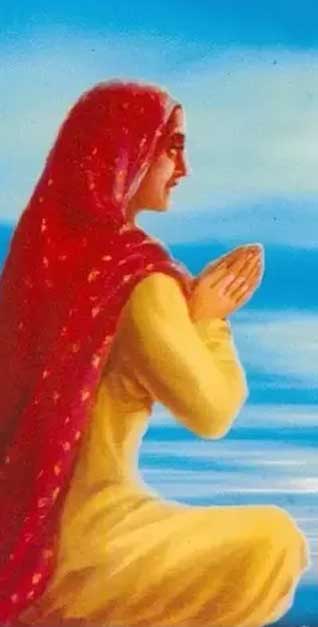Columnists
The Blood Of A Matriarch:
A Metaphysical Mystery Unfolds in Guru Amardas’ Goindwal
SARBPREET SINGH
Important events were unfolding in Goindwal.
Guru Amardas, who was starting to get very old, had decided that it was time to pick a successor. While there was an abundance of capable and devoted Sikhs around the Guru, he wanted to make sure that he chose a successor who was capable of carrying forward the mission of Guru Nanak and yet had the humility to serve the Sikh Panth.
After much introspection and a series of tests designed to winnow the field, he decided that there was none worthier than his son-in- law, Jetha, who had proven himself to be as humble and devoted as he was capable.
Guru Amardas’ daughter, Bibi Bhani, had been aware that her husband was the Guru’s choice but she had not let the fact go to her head. She had continued to serve her father with much devotion. She would fan him, draw water, tend to his every need and also work in the langar.
And then one morning, before the investiture of Jetha as Guru Ram Das, The Fourth Master, something happened that would forever change the destiny of her family and her descendants. The poet Santokh Singh paints a vivid picture of the incident in the Sri Gur Pratap Suraj Granth.
Guru Amardas rose before daybreak and, as was his custom, went to bathe. His daughter, accustomed to serving him, approached to assist him with his bath. The Guru seated himself on a low wooden stool and shut his eyes in deep meditation. He sat immovable and inscrutable like the mythical Shiva as he focused on simran. Just then, one of the pegs that supported the stool broke off, much to the alarm of Bhani. She could see that her father was in the kind of deep meditative state that even the most accomplished ascetics can achieve only with great difficulty.
She was concerned that if the Guru shifted his weight even slightly towards the broken peg, the stool could collapse on one side, and His simran would be interrupted.
She looked around for something she could use to prop up the stool and stabilize it, but found nothing. She then balled up her fist and slid her hand under the stool in order to keep it in place. Her delicate hand was crushed under the stool bearing the weight of the Guru’s body but she bore the pain unflinchingly and kept the stool steady. The pain was so intense that even a strong man would not be able to bear it, but Bhani stayed in that position until daybreak, as immovable as a statue.
Her arm was completely numb, swollen and bleeding, but she refused to move until finally it was time for the Guru to emerge from his naam simran. Guru Sahib became aware of his daughter’s presence and could not help notice her inflamed and bloodied arm. When he asked what she was doing, she simply replied that she had seen one of the pegs of the stool break off and explained that she was concerned that the Guru’s focus could’ve been hampered by the broken peg and not finding anything else to support the stool, she had decided to slide her hand under it to keep it stable.
The Guru rose quickly so that his daughter could withdraw her hand and looked at the terrible state it was in. While attending to it, he asked: ‘Why did you subject yourself to such pain, my child?”
“You are the epitome of divinity,” she answered. “Day and night I feel inadequate because I am unable to serve you like I believe you should be served. My eyes are blessed upon beholding you. My hands are blessed upon serving you. My heart is blessed when you reside in it. My feet are blessed because they bring me to you.”
The Guru, his heart touched by his daughter’s service and devotion, blessed her. The poet Santokh Singh richly imagines the scene:
The Guru, much pleased, gave her a boon
Flourish and grow shall your clan soon.
In worship shall creation swoon
As glorious as the crescent moon
Your clan shall thrive, comfort and joy
The service of the blest enjoy
Generations many shall spring forth
The mightiest warriors on this earth
Swords in hands will evil smite
Their glory shining brilliant bright
Righteous kingly spiritual brave
Bringers of change shall new ways pave
In this age dark their glories raved
Everywhere shall be thousands saved
Eternal glory of your tribe
Your service bids me to prescribe
Bibi Bhani’s service to the Guru had borne fruit. The Guru’s prophecy foretold the dazzling glory of her progeny. Bhani was ecstatic. Her father was the Guru. His prophecies would come true. She could not believe her good fortune.
The Guru’s prophecy did come true. The Gurus who followed Guru Ram Das were all descendants of Guru Ram Das and Bibi Bhani.
Max Arthur Macauliffe, writing about the Guru’s blessing thus given to his daughter in honour of her devotion, puts a slightly different slant on it, adding a small postscript:
He invited her to ask a favor. Her request was that the Guruship should remain in her family. He blessed her saying, “Thine offspring shall be worshipped by the world. From the offspring of thy womb shall be born a universal savior; but thou hast dammed the clear flowing stream of the Guruship, and consequently great trouble shall result.
I have heard this flavor of the tale elsewhere as well, sometimes even in gurdwaras where speakers often provide commentary and historical insight drawn from traditional Sikh literature. The broad thesis is that Bibi Bhani selfishly asked that all the subsequent Gurus come exclusively from her progeny. Since Guru Amar Das had encouraged her to ask for a boon, he was honor bound to grant her wish. But her wish was at odds with the command of Guru Nanak: that the throne of the faith be offered to the humblest and most faithful disciples, on merit alone.
For that reason, Bibi Bhani’s victory was bittersweet. Her descendants be blessed as requested, but they would also have to endure terrible tragedy and pain.
We do not have unimpeachable historical sources to tell us what actually transpired. Personally speaking, I find it difficult to reconcile the image of the introspective, humble and devout Bibi Bhani with the notion that she was selfish for her offspring.
Yet it cannot be denied that after Guru Ram Das’s ascension, things did change. The writer Harinder Singh Mehboob provides an interesting perspective. In his opus, Sehjai Rachhyo Khalsa, in a chapter titled ‘The Principles of Succession to the Guruship‘, Harinder Singh speculates about what might have happened. This is a translation from the original Punjabi:
One may wonder why the Guruship stayed within one family after Guru Ram Das. This question is answered beautifully by the divine imagination and spiritual consciousness of Bibi Bhani. As Bibi Bhani’s blood flowed, when her limbs were crushed under the stool, Guru Amar Das hinted at the rivers of blood that were to flow in the future.
Bibi Bhani, in a flash foresaw the martyrdom of her descendants in the pool of her blood. All the pain and suffering that her progeny were to endure was experienced by Bibi Bhani at that moment. History bears witness to the fact even though the subsequent Gurus descended from one family, they were unequivocal in their commitment to the faith and its principles.
The bonds of kinship and family were inconsequential in comparison to their diligent service to The Almighty and their followers. The vision of the Gurus to follow in the spilled blood of Bibi Bhani and the indication of their martyrdom and suffering cannot be explained in mundane, worldly terms.
Bibi Bhani’s intense compassion, which manifested itself in her blood and her sacrifice, will forever remain a metaphysical mystery.
These are the words of a poet rather than those of a historian. I have to confess that I find them deeply satisfying.
* * * * *
[This article is adapted from the script of ‘The Story Of The Sikhs‘, a Sikh History podcast, written and narrated by Sarbpreet Singh. Edited for sikhchic.com. All ten episodes of Season One are now available. This story is from Episode 6.]
The author - a playwright, commentator and poet - is the writer and narrator of ‘The Story Of The Sikhs‘. He is the author of ‘Kultar’s Mime‘, a poem about the 1984 Sikh Genocide. His commentary has appeared on The Huffington Post, NPR’s Morning Edition, etc., and he is a regular columnist with sikhchic.com. He is the founder and director of the Gurmat Sangeet Project, a non-profit dedicated to the preservation of traditional Sikh music.
April 16, 2018
Conversation about this article
1: Harmeet Singh (New Jersey, USA), April 20, 2018, 7:12 AM.
How does it make any sense to self-inflict yourself with pain, in this case?



